List of mammals of Georgia (country)
This is a list of the mammal species recorded in the country of Georgia. There are 80 mammal species in Georgia, of which 1 is critically endangered, 2 are endangered, 10 are vulnerable, and 2 are near-threatened.[1]
The following tags are used to highlight each species' conservation status as assessed by the IUCN:
| EX | Extinct | No reasonable doubt that the last individual has died. |
| EW | Extinct in the wild | Known only to survive in captivity or as a naturalized populations well outside its previous range. |
| CR | Critically endangered | The species is in imminent risk of extinction in the wild. |
| EN | Endangered | The species is facing an extremely high risk of extinction in the wild. |
| VU | Vulnerable | The species is facing a high risk of extinction in the wild. |
| NT | Near threatened | The species does not meet any of the criteria that would categorise it as risking extinction but it is likely to do so in the future. |
| LC | Least concern | There are no current identifiable risks to the species. |
| DD | Data deficient | There is inadequate information to make an assessment of the risks to this species. |
Some species were assessed using an earlier set of criteria. Species assessed using this system have the following instead of near threatened and least concern categories:
| LR/cd | Lower risk/conservation dependent | Species which were the focus of conservation programmes and may have moved into a higher risk category if that programme was discontinued. |
| LR/nt | Lower risk/near threatened | Species which are close to being classified as vulnerable but are not the subject of conservation programmes. |
| LR/lc | Lower risk/least concern | Species for which there are no identifiable risks. |
Subclass: Theria
Infraclass: Eutheria
Order: Rodentia (rodents)


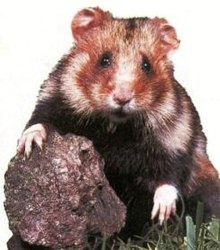
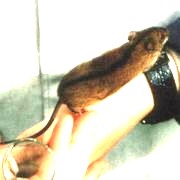
Rodents make up the largest order of mammals, with over 40 percent of mammalian species. They have two incisors in the upper and lower jaw which grow continually and must be keep short by gnawing. Most rodents are small though the capybara can weigh up to 45 kg (100 lb).
- Suborder: Hystricognathi
- Family: Hystricidae (Old World porcupines)
- Genus: Hystrix
- Indian porcupine Hystrix indica LR/lc
- Genus: Hystrix
- Family: Hystricidae (Old World porcupines)
- Suborder: Sciurognathi
- Family: Sciuridae (squirrels)
- Subfamily: Sciurinae
- Tribe: Sciurini
- Genus: Sciurus
- Caucasian squirrel Sciurus anomalus LR/nt
- Genus: Sciurus
- Tribe: Sciurini
- Subfamily: Xerinae
- Tribe: Marmotini
- Genus: Spermophilus
- Caucasian mountain ground squirrel Spermophilus musicus LR/lc
- Little ground squirrel Spermophilus pygmaeus LR/lc
- Genus: Spermophilus
- Tribe: Marmotini
- Subfamily: Sciurinae
- Family: Gliridae (dormice)
- Subfamily: Leithiinae
- Genus: Dryomys
- Forest dormouse Dryomys nitedula LR/nt
- Genus: Dryomys
- Subfamily: Glirinae
- Genus: Glis
- Edible dormouse Glis glis LR/nt
- Genus: Glis
- Subfamily: Leithiinae
- Family: Dipodidae (jerboas)
- Subfamily: Allactaginae
- Genus: Allactaga
- Small five-toed jerboa Allactaga elater LR/lc
- Genus: Allactaga
- Subfamily: Sicistinae
- Genus: Sicista
- Northern birch mouse Sicista betulina LR/nt
- Kazbeg birch mouse Sicista kazbegica DD
- Genus: Sicista
- Subfamily: Allactaginae
- Family: Spalacidae
- Subfamily: Spalacinae
- Genus: Nannospalax
- Nehring's blind mole-rat Nannospalax nehringi LR/lc
- Genus: Nannospalax
- Subfamily: Spalacinae
- Family: Cricetidae
- Subfamily: Cricetinae
- Genus: Cricetus
- European hamster Cricetus cricetus LR/lc
- Genus: Mesocricetus
- Turkish hamster Mesocricetus brandti LR/lc
- Genus: Cricetus
- Subfamily: Arvicolinae
- Genus: Chionomys
- Caucasian snow vole Chionomys gud LR/nt
- Snow vole Chionomys nivalis LR/nt
- Robert's snow vole Chionomys roberti LR/nt
- Genus: Ellobius
- Transcaucasian mole vole Ellobius lutescens LR/lc
- Genus: Microtus
- Altai vole Microtus obscurus LR/lc
- Genus: Prometheomys
- Long-clawed mole vole Prometheomys schaposchnikowi LR/lc
- Genus: Chionomys
- Subfamily: Cricetinae
- Family: Muridae (mice, rats, voles, gerbils, hamsters, etc.)
- Subfamily: Murinae
- Genus: Apodemus
- Striped field mouse Apodemus agrarius LR/lc
- Yellow-breasted field mouse Apodemus fulvipectus LR/lc
- Broad-toothed field mouse Apodemus mystacinus LR/lc
- Black Sea field mouse Apodemus ponticus LR/lc
- Ural field mouse Apodemus uralensis LR/lc
- Genus: Micromys
- Harvest mouse Micromys minutus LR/nt
- Genus: Apodemus
- Subfamily: Murinae
- Family: Sciuridae (squirrels)
Order: Erinaceomorpha (hedgehogs and gymnures)
The order Erinaceomorpha contains a single family, Erinaceidae, which comprise the hedgehogs and gymnures. The hedgehogs are easily recognised by their spines while gymnures look more like large rats.
- Family: Erinaceidae (hedgehogs)
- Subfamily: Erinaceinae
- Genus: Erinaceus
- Southern white-breasted hedgehog Erinaceus concolor LR/lc
- Genus: Erinaceus
- Subfamily: Erinaceinae
- Family: Erinaceidae (hedgehogs)
Order: Soricomorpha (shrews, moles, and solenodons)
The "shrew-forms" are insectivorous mammals. The shrews and solenodons closely resemble mice while the moles are stout-bodied burrowers.
- Family: Soricidae (shrews)
- Subfamily: Crocidurinae
- Genus: Crocidura
- Gueldenstaedt's shrew Crocidura gueldenstaedtii LR/lc
- Bicolored shrew Crocidura leucodon LR/lc
- Lesser white-toothed shrew Crocidura suaveolens LR/lc
- Genus: Suncus
- Etruscan shrew Suncus etruscus LC
- Genus: Crocidura
- Subfamily: Soricinae
- Tribe: Nectogalini
- Genus: Neomys
- Transcaucasian water shrew Neomys schelkovnikovi LR/lc
- Genus: Neomys
- Tribe: Soricini
- Genus: Sorex
- Eurasian pygmy shrew Sorex minutus LR/lc
- Radde's shrew Sorex raddei LR/lc
- Caucasian pygmy shrew Sorex volnuchini LR/lc
- Genus: Sorex
- Tribe: Nectogalini
- Subfamily: Crocidurinae
- Family: Soricidae (shrews)
Order: Chiroptera (bats)

The bats' most distinguishing feature is that their forelimbs are developed as wings, making them the only mammals in the world naturally capable of flight. Bat species account for about 20% of all mammals.
- Family: Vespertilionidae
- Subfamily: Myotinae
- Genus: Myotis
- Bechstein's bat Myotis bechsteini VU
- Lesser mouse-eared bat Myotis blythii LR/lc
- Geoffroy's bat Myotis emarginatus VU
- Natterer's bat Myotis nattereri LR/lc
- Genus: Myotis
- Subfamily: Vespertilioninae
- Genus: Barbastella
- Barbastelle Barbastella barbastellus VU
- Asian barbastelle Barbastella leucomelas LR/lc
- Genus: Eptesicus
- Northern bat Eptesicus nilssoni LR/lc
- Genus: Hypsugo
- Savi's pipistrelle Hypsugo savii LR/lc
- Genus: Nyctalus
- Greater noctule bat Nyctalus lasiopterus LR/nt
- Lesser noctule Nyctalus leisleri LR/nt
- Genus: Pipistrellus
- Kuhl's pipistrelle Pipistrellus kuhlii LC
- Nathusius' pipistrelle Pipistrellus nathusii LR/lc
- Common pipistrelle Pipistrellus pipistrellus LC
- Genus: Plecotus
- Brown long-eared bat Plecotus auritus LR/lc
- Grey long-eared bat Plecotus austriacus LR/lc
- Genus: Barbastella
- Subfamily: Miniopterinae
- Genus: Miniopterus
- Schreibers' long-fingered bat Miniopterus schreibersii LC
- Genus: Miniopterus
- Subfamily: Myotinae
- Family: Rhinolophidae
- Subfamily: Rhinolophinae
- Genus: Rhinolophus
- Mediterranean horseshoe bat Rhinolophus euryale VU
- Greater horseshoe bat Rhinolophus ferrumequinum LR/nt
- Lesser horseshoe bat Rhinolophus hipposideros LC
- Mehely's horseshoe bat Rhinolophus mehelyi VU
- Genus: Rhinolophus
- Subfamily: Rhinolophinae
- Family: Vespertilionidae
Order: Cetacea (whales)


The order Cetacea includes whales, dolphins and porpoises. They are the mammals most fully adapted to aquatic life with a spindle-shaped nearly hairless body, protected by a thick layer of blubber, and forelimbs and tail modified to provide propulsion underwater.
- Suborder: Mysticeti
- Family: Balaenopteridae (rorquals)
- Genus: Balaenoptera
- Common minke whale, Balaenoptera acutorostrata LC (vagrant)[2]
- Genus: Balaenoptera
- Family: Balaenopteridae (rorquals)
- Suborder: Odontoceti
- Superfamily: Platanistoidea
- Family: Phocoenidae
- Genus: Phocoena
- Harbour porpoise Phocoena phocoena VU
- Genus: Phocoena
- Family: Delphinidae (marine dolphins)
- Genus: Tursiops
- Common bottlenose dolphin Tursiops truncatus DD
- Genus: Delphinus
- Short-beaked common dolphin Delphinus delphis LR/lc
- Genus: Tursiops
- Family: Phocoenidae
- Superfamily: Platanistoidea
Order: Carnivora (carnivorans)
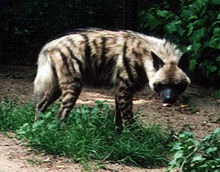

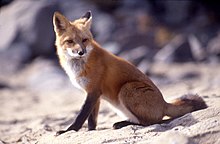
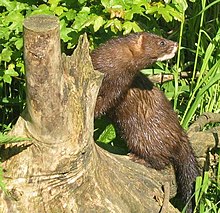
There are over 260 species of carnivorans, the majority of which feed primarily on meat. They have a characteristic skull shape and dentition.
- Suborder: Feliformia
- Family: Felidae (cats)
- Subfamily: Felinae
- Genus: Acinonyx
- Asiatic cheetah Acinonyx jubatus venaticus CR
- Genus: Felis
- Caucasian wildcat Felis silvestris caucasica LC
- Genus: Lynx
- Caucasian lynx Lynx lynx dinniki VU
- Genus: Acinonyx
- Subfamily: Pantherinae
- Genus: Panthera
- Asiatic lion Panthera leo persica EN
- Persian leopard Panthera pardus ciscaucasica EN
- Caspian tiger Panthera tigris virgata EX
- Genus: Panthera
- Subfamily: Felinae
- Family: Hyaenidae (hyaenas)
- Genus: Hyaena
- Striped hyena Hyaena hyaena LR/nt
- Genus: Hyaena
- Family: Felidae (cats)
- Suborder: Caniformia
- Family: Canidae (dogs, foxes)
- Genus: Vulpes
- Red fox Vulpes vulpes LC
- Genus: Canis
- Steppe wolf Canis lupus campestris LC
- Eurasian wolf Canis lupus lupus LC
- Genus: Vulpes
- Family: Ursidae (bears)
- Genus: Ursus
- Syrian brown bear Ursus arctos syriacus VU
- Genus: Ursus
- Family: Mustelidae (mustelids)
- Genus: Mustela
- Stoat Mustela erminea LR/lc
- Steppe polecat Mustela eversmannii LR/lc
- European mink Mustela lutreola EN
- Least weasel Mustela nivalis LR/lc
- Genus: Vormela
- Marbled polecat Vormela peregusna LR/lc
- Genus: Martes
- Beech marten Martes foina LR/lc
- Pine marten Martes martes LR/lc
- Genus: Meles
- Eurasian badger Meles meles LR/lc
- Genus: Lutra
- European otter Lutra lutra NT
- Genus: Mustela
- Family: Phocidae (earless seals)
- Genus: Monachus
- Mediterranean monk seal Monachus monachus CR
- Genus: Monachus
- Family: Canidae (dogs, foxes)
Order: Artiodactyla (even-toed ungulates)
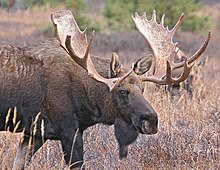
The even-toed ungulates are ungulates whose weight is borne about equally by the third and fourth toes, rather than mostly or entirely by the third as in perissodactyls. There are about 220 artiodactyl species, including many that are of great economic importance to humans.
- Family: Cervidae (deer)
- Family: Bovidae (cattle, antelope, sheep, goats)
- Subfamily: Antilopinae
- Genus: Gazella
- Goitered gazelle Gazella subgutturosa VU
- Genus: Gazella
- Subfamily: Caprinae
- Genus: Capra
- Wild goat Capra aegagrus VU
- West Caucasian Tur Capra caucasica EN
- East Caucasian Tur Capra cylindricornis VU
- Genus: Ovis
- Argali Ovis ammon VU
- Genus: Rupicapra
- Chamois Rupicapra rupicapra LR/lc
- Genus: Capra
- Subfamily: Antilopinae
See also
- List of chordate orders
- List of regional mammals lists
- List of prehistoric mammals
- Mammal classification
- New mammal species
Notes
- ^ This list is derived from the IUCN Red List which lists species of mammals and includes those mammals that have recently been classified as extinct (since 1500 AD). The taxonomy and naming of the individual species is based on those used in existing Wikipedia articles as of 21 May 2007 and supplemented by the common names and taxonomy from the IUCN, Smithsonian Institution, or University of Michigan where no Wikipedia article was available.
- ^ The Status of Cetaceans in the Black Sea and Mediterranean Sea
References
- [1]
- "The IUCN Red List of Threatened Species: Mammals of Georgia". IUCN. 2001. Retrieved 22 May 2007. [dead link]
- "Mammal Species of the World". Smithsonian National Museum of Natural History. 2005. Archived from the original on 27 April 2007. Retrieved 22 May 2007.
- "Animal Diversity Web". University of Michigan Museum of Zoology. 1995–2006. Retrieved 22 May 2007.

